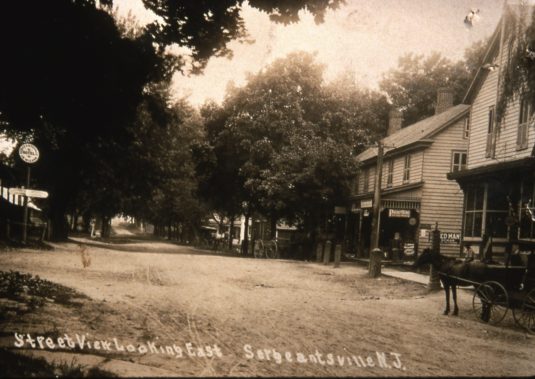Recently there has been much discussion on the Facebook page “Historical Kingwood Township” about the history of Baptistown. So, it seems appropriate now to publish this article by Egbert T. Bush with his memories of the ancient village.
churches
Sandy Ridge, part two
This is my second article on the neighborhood of Sandy Ridge in Delaware Township. The previous article was written by Jonathan M. Hoppock in 1905 (and heavily annotated by me.) Today’s article was written by Egbert T. Bush, over 25 years later.
Sandy Ridge Church
This past fall, an application was prepared to create a Sandy Ridge Historic District in Delaware Township. This area is full of interesting properties, with the old Sandy Ridge Baptist Church standing at its center.
A Sergeantsville History
 While working on a history of the Sergeantsville Inn, I realized that this would be a good time to publish Egbert T. Bush’s article about the places that made Sergeantsville such an interesting little town. Mr. Bush did not have the advantage of adding photographs the way I do. These pictures come from the postcard collection of Paul Kurzenberger. (Note that Mr. Bush’s article is in italics; my comments are not.)
While working on a history of the Sergeantsville Inn, I realized that this would be a good time to publish Egbert T. Bush’s article about the places that made Sergeantsville such an interesting little town. Mr. Bush did not have the advantage of adding photographs the way I do. These pictures come from the postcard collection of Paul Kurzenberger. (Note that Mr. Bush’s article is in italics; my comments are not.)
The Amwell Church of the Brethren
There is a small church in Delaware Township with a very long history. It is known as the Amwell Church of the Brethren, sometimes called the Dunkard Church for its practice of adult baptism. It seems to be a sort of outlier, quite different from the major religious groups who first appeared in Hunterdon County. Those were Quaker, Baptist, Presbyterian, Anglican (Episcopalian), Lutheran, Methodist, German Calvinist, and Dutch Reformed. They all had congregations throughout the county and hundreds of worshippers. But the Brethren church didn’t even have a church building until 1811, and never grew to any great size, despite two spin-off churches. And yet, it has endured for 283 years. Although that is a long time, there are eight church in Hunterdon County that were founded before 1733. They are:
The German Baptist Church in Amwell
Here are two versions of the history of the Amwell Church of the Brethren in Hunterdon County. The first was written by Jonathan M. Hoppock and published in the Democrat-Advertiser on October 17, 1901. Short and sweet. The second one, a little bit longer, was written by Egbert T. Bush and published in the Hunterdon County Democrat on March 26, 1931. Mr. Bush’s ‘history’ is truncated, and as he put it— “it is not the intent to give here anything more than the merest sketch of church history, an indispensable part in any sketch of the community.” He was always more interested in the members of a community than institutional histories, and so he spends more time on those who were buried in the three cemeteries associated with the church members.
The Moore Family
I have written a few articles recently concerning the neighborhood of Bowne Station (“The Daybooks of Dr. Bowne,” “The Bowne Homestead,” “Bowne Station” and “The Bosenbury and Taylor Graveyards”), and have frequently come across references to the first settlers in that area, one Jacob Moore and his wife, Apolonia Amy Moret. Just when I thought I had published all articles by Egbert T. Bush and Jonathan M. Hoppock pertaining to the early history of the Moore family in Amwell, another one turned up. Actually, two articles, “Old Farms in Old Hunterdon” and “Farewell Relic of Another Age.”
Ellicott’s Diary, Local News
Recently I wrote about the diary of Benjamin H. Ellicott, a Baltimore man who married into a Hunterdon family, and traveled with his family from Baltimore to Flemington in 1861.1
“Copperheadism” in Locktown
During the Civil War, Republicans called Democrats who opposed the war “Copperheads,” likening them to poisonous snakes. Many of these “Copperheads” could be found in Northern States like New Jersey, and in Hunterdon County.
Some Controversial Baptist Ministers
My original intention was to publish an article by Jonathan M. Hoppock on the history of the Baptist Church in Locktown. And that is what I will do here, but after reading his article, I discovered that some of the ministers he listed had troubled careers, and that, of course, makes them interesting. But first, here is Mr. Hoppock’s history of the Church.